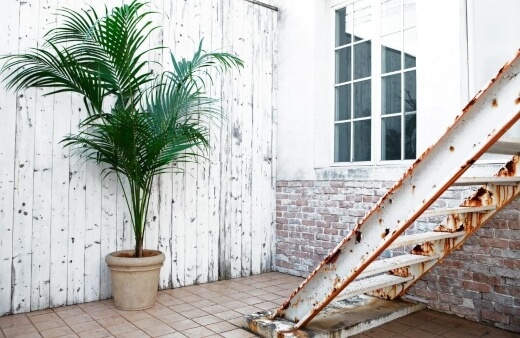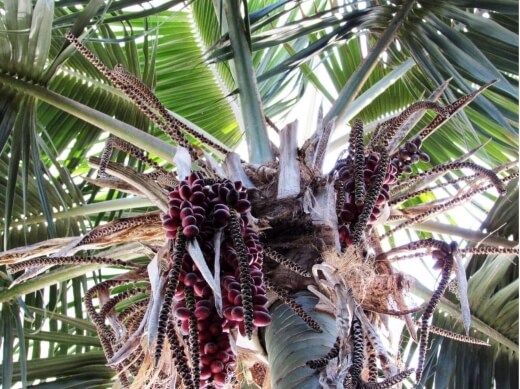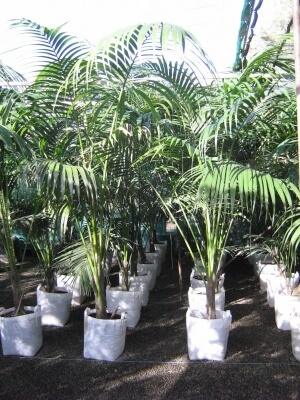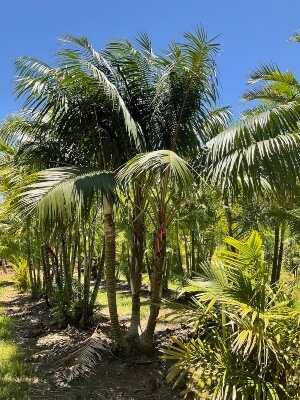The Kentia Palm might make you think a bit of a dancer in the way it gracefully holds itself. It’s the kind of plant you are probably already familiar with (you would know it if you saw it), because this palm is indeed a worldwide wonder.
In our growing guide, we’ll introduce you to this beauty, go through some growing and care tips, share some of the common pests and ailments that might affect the plant, and also outline a few frequently asked questions.
More...
Genus: | Howea |
|---|---|
Species: | H. forsteriana |
Family: | Arecaceae |
Common Name: | Kentia palm, Thatch palm |
Plant Type: | Tropical |
Mature Size: | Up to 3.6 metres tall (indoors) and 1.2 metres wide (indoors) |
Sun Exposure: | Partial shade, shade |
Soil Type: | Sandy, well-drained |
Soil pH: | Acidic |
Flower Colour: | White |
Native to: | South Pacific |
Maintenance level: | Low |
Poisonous to pets: | No |
Introducing Kentia Palm

The Kentia palm has earned itself the reputation of one of the world's most popular indoor palms. Part of the appeal is certainly that it's shade and cold tolerant, and doesn't grow too big.
The Kentia palm is native to the islands of the South Pacific and is usually sold with two to five palms planted together, which makes the plant look like it has multiple stems. The graceful and arching leaves are beautiful.
This palm has a long history as a parlour palm. Queen Victoria added them to all of her homes and they were also the feature of palm courts at hotels like The Ritz Hotel in London and The Plaza Hotel in New York.
The Kentia palm can live outdoors in tropic-like environments but generally it’s chosen as a houseplant so it can be enjoyed all year long. Howea forsteriana is the Kentia palm's botanical name but it is more commonly known as thatch palm or palm court palm.
It is a species of flowering plant in the palm family, Arecaceae, which is endemic to Lord Howe Island in Australia and is also grown on Norfolk Island. This is a slow-growing palm, and can grow up to 10 metres tall by 6 metres wide. The fronds can reach 3 metres long.
Kentia Palm's History

If you’re wondering about the name, the Kentia palm was given the name "forsteriana" after Johann Reinhold Forster and Georg Forster, father and son, who accompanied Captain Cook as naturalists on his second voyage to the Pacific in 1772–1775.
The Kentia palm species is labelled as vulnerable by the World Conservation Union. The plant is cultivated on Lord Howe Island by collecting wild seeds and germinating them for export as an ornamental garden or house plant but the trade is strictly regulated. Kentia palm has also earned the Royal Horticultural Society's Award of Garden Merit.
Howea forsteriana Overview
The Kentia palm is a low maintenance plant but a bit of extra care goes a long way. Choose a spot for your plant that is bright but out of direct sunlight. Kentia palms love bright, indirect light but will tolerate a bit of shade.
Avoid direct sunlight as this will burn the leaves. You should also keep your palm away from draughts. They like a warm room, around 18°-24°C, with a minimum of 12°C. They do best in a humid environment.
Water only when the top of the compost is dry in spring and summer and you can reduce watering in autumn and winter. Feed with a liquid feed once a month in spring and summer.
You can place the palm on a dish of wet pebbles, or mist the plant a few times a week.
How to Grow Kentia Palm in Australia
Kentia palm seeds are orange or red in colour and its fruits can take up to four years to mature. The mature Kentia palm fruits are a pale dark red.


Get Your Free Guide:
Master Growing Australian Natives eBook
A Must Have Complete Guide for Every Australian Garden
Get Your Free Guide:
Master Growing Australian Natives eBook
A Must Have Complete Guide for Every Australian Garden
You can remove them from the palm and soak them in warm water. After a few days you can then pull the fruits off the seeds.

Germinating Kentia Palm Seeds
Clean the seeds so there is no remaining fruit residue which can cause fungi to grow. To germinate the seeds, you either need to place them in a sealable plastic bag with soil mix or put them in planting trays.
Sow your seeds about 15cm into well-draining soil. Water the soil so that the seeds are hydrated enough but be sure to drain out any extra moisture.
If the seeds get too wet they will rot. Place the bag or planting trays in indirect sunlight or partial shade. You want to avoid direct sunlight and you’re aiming for temperatures between 18 and 24°C to help the germination process.
If you are planting the seedlings outside, place them in partial shade. Kentia palms must be at least 5 years old before they can grow in full sun.
If you are growing indoors, do not place the container directly in front of windows.
Transplanting Kentia Palm
Moving any mature palm tree can be tricky, but healthy Kentia palms that have thick, woody trunks are quite resilient. Transplant your palm in the spring or early summer when the soil is warm.
Choose a spot where the palm tree can grow freely and have enough space to spread. Dig a hole in the ground that is as deep as the tree’s current container and twice as wide as the size of the palm’s root ball.
Lift the tree from the bottom and place it in the hole. Fill the area around the roots with soil and give it quite a few centimetres of water. You can then add more soil to fill the hole and put mulch around the tree.
If the trunk is bending you can secure the tree by placing cloth strips around its trunk and attaching them to three wooden stakes in the ground, arranged in a triangle.
Caring for Kentia Palm

Source: leonandgeorge.com
To keep your Kentia palm happy, you need to think tropical. For your plant to thrive, you need to replicate its natural conditions as much as possible – this includes balmy temperatures and humidity.
The plant allows for a versatile placement, and will live happily from the bathroom to bedroom. Once established, the Kentia palm needs very little care.
You’ll need to wipe the fronds clean now and then as they can collect dust indoors. Try to avoid replanting the palm unless absolutely necessary. Prune only if you notice brown or yellow fronds which you can then trim.
Light Preference
Kentia palms like indirect sunlight. Try not to expose the plant to direct sun unless it becomes used to it as a seedling. If you don’t, the palm will scorch. It can grow in low light but you will get more foliage if they get soft, filtered light - six to eight hours a day is ideal.
Best Soil to Use
When it comes to planting your Kentia palm, you don’t need to worry too much about the soil. They're not that picky. This plant can adapt to a variety of mixtures, including clay, loam, and sand.
Whatever mixture you choose, make sure it’s well-draining to prevent root rot. If your garden soil is keeping you up at night, have a read through our article about the 5 common garden soil problems and solutions.
Watering Kentia Palm
The Kentia palm likes to be well-hydrated, but not soggy. Water weekly in the spring and summer and allow the soil to dry out between watering. In the autumn and winter months, you can slow down a bit.
If you notice yellowing leaves, that can mean too much water or root rot. Brown tips on the plant's fronds can indicate that the plant needs more water.
Temperature and Humidity
Inspired by all that is tropical, the Kentia palm likes warmer temperatures and lots of humidity. It’s hardier than most other palms and can tolerate temperatures as low as -4°C but the ideal temperature is around 13°C.
The Kentia palm will do well with added humidity, so spray the leaves lightly at least once a week. If your home is very dry, you can increase the plant's humidity by placing its container on a bed of wet rocks.
Fertilising Kentia Palm
You should aim to fertilise monthly but only in the spring and summer. We suggest liquid fertiliser or slow-release pellets, like a specially-formulated palm fertiliser. If you fertilise too much, you might see the tips of the lower leaves turn brown.
Kentia Palms are known for potassium deficiencies and you might notice this as necrosis on the tips of the oldest leaves first. In order to ensure your Kentia Palm gets enough nutrients, feed it with a control release potassium supplement.
How to Propagate Kentia Palm

Source: palmsgalore.com.au
Start by laying down an old towel. Remove the palm from its flower pot and shake as much soil from the roots as possible. Put the roots of the plant on the old towel.
Move the roots under running water which will cause the roots to separate from each other by themselves. Separate roots where necessary. As soon as you have taken the roots apart properly, you can divide the plant into several pups.
Repot the cuttings in a flowerpot with fresh potting soil and immediately after repotting, water the cuttings. It is important to keep the cuttings moist in the first period after cutting as the humidity stimulates root growth.
Kentia Palm Pests and Diseases to Look Out For
Mealybugs and spider mites are the most common pests that affect the Kentia palm. If you are treating your palm for these pests, try to avoid any alcohol-based products, which can dry out the delicate leaves.
Rather use an insecticidal soap or neem oil instead. You can clean the fronds once a month with a spray of water and a damp cloth to remove dust and help prevent spider mites.

Source: bigislandbigtrees.com
Here are other things to look out for:
- Brown leaf tips - Brown leaf tips are common on Kentia palms and are usually because the air is too dry. It might also be too cold, or the plant may be under watered. You can cut the brown tips off. Just don’t cut into green growth which will just create brown tips again.
- Yellowing leaves - Yellowing leaves are normal on lower leaves as they age. Widespread yellow leaves could mean too much direct sun or under-watering.
- Brown fronds - Brown fronds at the base of the palm are normal and you can just cut these away. Widespread brown leaves could mean overwatering. Kentia palms hate cold, soggy compost.
- Brown patches on leaves - Brown patches could be caused by sunburn so move the plant out of direct sunlight.
- Dull leaves - Dull leaves that have lost their shine could mean insufficient humidity. Misting will help and move the palm away from any heating sources.
- Fine webbing around the leaves and stems - Red spider mite can affect Kentia Palms. The leaves and stems of the plant become covered in fine webbing and the top of the leaf becomes mottled.
If you look with a magnifying glass, you will see mites and eggs on the undersides of the leaves. The best defence is to improve air circulation and boost humidity. You can also use sprays containing fatty acids or plant oils. - Fluffy white blobs on leaf undersides - Mealybugs might be the problem here. Look for insects that look like white, fluffy blobs on the undersides of the leaves.
You can wipe them off with a damp cloth or cotton bud that has been soaked in an insecticide that contains fatty acids or plant oils. Keep checking the leaves, as mealybugs can be hard to get rid of. - Raised brown spots – this might mean scale insects which are small, brown sap sucking insects. You can wipe them off with a cotton bud or cloth soaked with an organic insecticide containing fatty acids.
Kentia Palm Frequently Asked Questions

Source: petalrepublic.com
How fast does a Kentia palm grow?
One of the best things about growing a Kentia Palm indoors is that it’s a naturally slow grower. It usually takes more than five years for the palm grown indoors to reach its average height.
Do Kentia palms produce flowers?
Kentia Palms will sometimes flower, producing white flowers and a red, egg-shaped fruit.
Is Areca Palm the same as Kentia palm?
You can tell the difference based on the stems above the soil. The Kentia Palm's stems are green with brown fibres on the stem. The Areca Palm stems have red spots. Kentia Palm's leaves are also wider than those of the Areca Palm.
Who are the common plant palm relatives to the Kentia palm?
As a member of the Palmae (palm) family, its common relatives are palms including the coconut, date and oil palms.
How do I know if my Kentia palm is getting enough light?
This palm will generally grow well in light levels that are bright enough to read a newspaper comfortably.
For more palm info and inspirations, have a look at our list of palm growing guides:

Wrapping Up Our Kentia Palms Guide
If Queen Victoria made it a point to add a Kentia Palm to each of her homes, she must have been onto something. It might be considered a vulnerable species, and perhaps this has just added to its appeal as one of the world’s most popular houseplants.
Looking to bring a bit of the tropics home? This South Pacific native is low maintenance and grows to an impressive height. The slow growing palm is worth the wait and might even surprise you with a display of flowers when you least expect it. We’re giving the Kentia palm our green thumbs up!
Published on June 27, 2022 by Maisie Blevins
Last Updated on February 26, 2024




